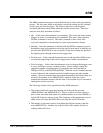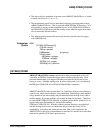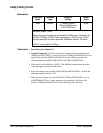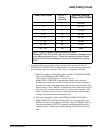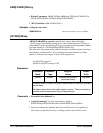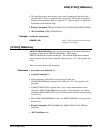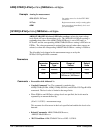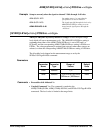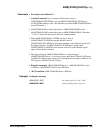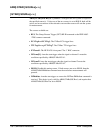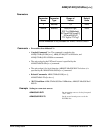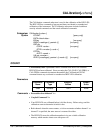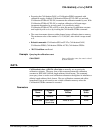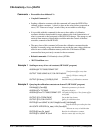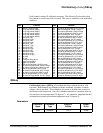
• When POSitive and NEGative voltage levels are specified, the levels must be
separated by an amount defined by:
(50 mV / 1.0235V)
*
measurement range
This accounts for offset errors in the levels specified, and enables arms at those
levels to be accepted.
• Related Commands: ARM:STARt:SOURce<n>, ARM:STARt:SLOPe<n>
• *RST Condition: ARM:STARt:LEVel<n >:POS 1.022418
Example Setup to arm when the signal on channel 1 goes outside of a the window
bounded by 0.5V and 0V.
ARM:SOUR1 INT1 Set arming source 1 to be channel 1 level(s).
ARM:LEV1:POS 0.50
ARM:LEV1:NEG 0
ARM:SLOP1 EITH Specify that both ARM:LEVel1:POS and
ARM:LEVel1:NEG will be used to form a
window. If the signal rises above the 0.5
volt level (the POSitive slope level
specified), or falls below the 0 volt level (the
NEGative slope level specified), arming will
occur and the measurement will proceed.
[:STARt]:SLOPe[<
n
>]
ARM[:STARt]:SLOPe[<n >] <edge > selects which edge - POSitive, NEGative,
or EITHer on arming source <n > will cause the arm event to occur.
ARM:STARt:SLOPe is only active when either of the two arm sources is set to
EXTernal1, INTernal1, or INTernal2. The "EITHer" setting may be used only when
the corresponding ARM:STARt:SOURce is set to INTernal<n >. The "EITHer"
setting causes the window specified by ARM:STARt:LEVel<chan>:POSitive and
ARM:STARt:LEVel<chan>:NEGative to be in effect.
Parameters
Parameter
Name
Parameter
Type
Range of
Values
Default
Units
n
numeric 1|2 none
edge
discrete NEGative|POSitive|
EITHer
none
ARM[:STARt]:SLOPe[<
n
>]
194 Command Reference ARM Subsystem



